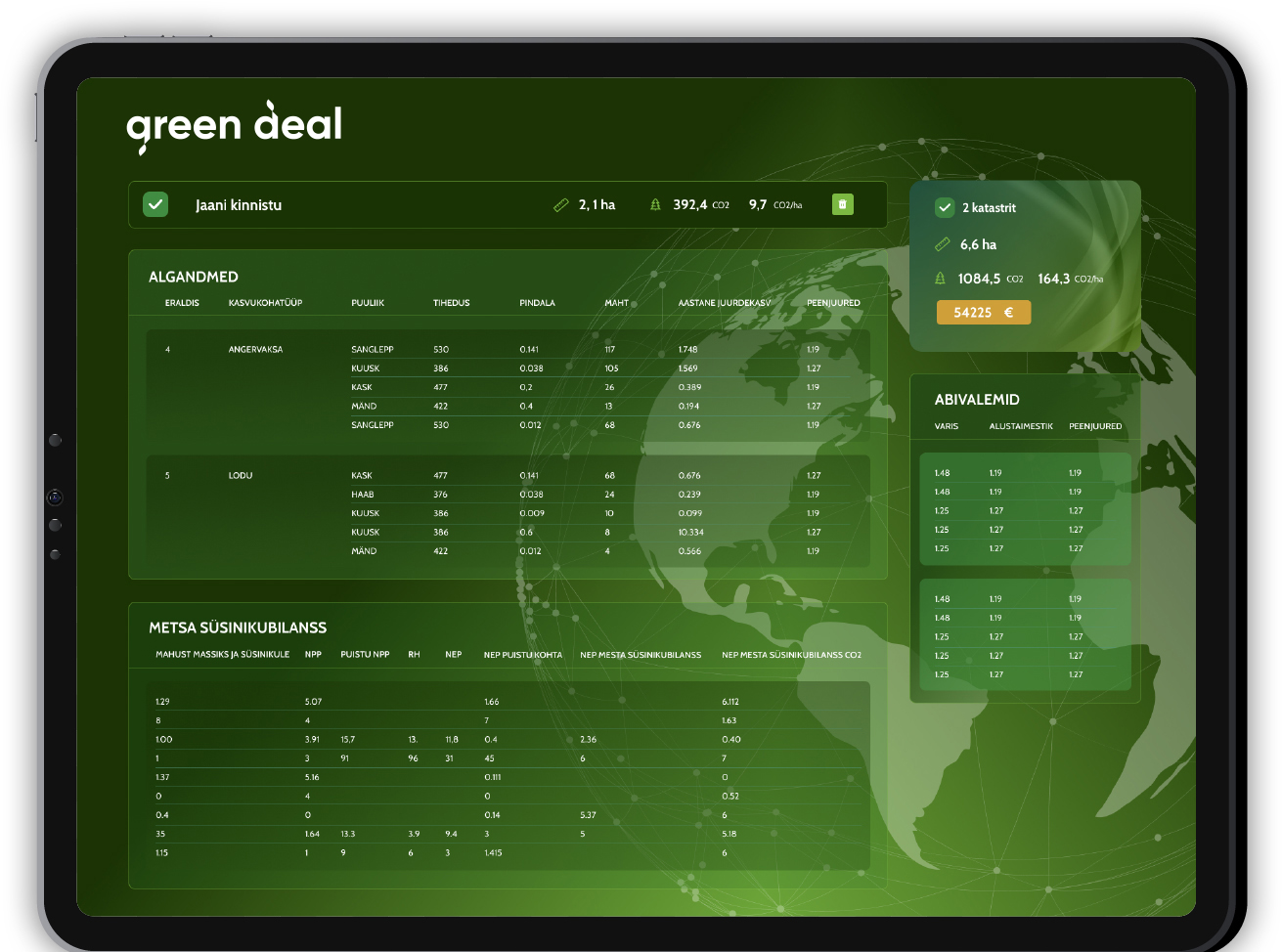Süsiniku tasakaalustamise programm metsa omanikule
Tõsta oma maa väärtust, panusta keskkonda ja
teeni tulu süsinikukrediitide müügist








Kliimaeesmärkide saavutamiseks tuleb ettevõtetel vähendada oma tegevusega seotud kasvuhoonegaaside teket. Alati ei ole neil endil võimalik seda piisavalt kiiresti teha. Seetõttu soovivad ettevõtted osta süsinikukrediiti, et enda tekitatud heitmeid loodusele korvata.
Pool Eesti pindalast on kaetud metsadega. CO2 neelates aitavad metsad ja metsastavad maad tekitatud saastet kompenseerida.
Süsinikukrediit on sertifikaat, millega ettevõte tõendab, et ta on tasunud teatud koguse CO2 keskkonnast eemaldamise eest.
GreenDeal süsinikuprogramm on loodud metsaomanikule, kes näeb oma maas ja metsas pikaajalist investeeringut ja on koostöös metsandusekspertidega valmis järgima CO2 sõbralikke metsamajandamise põhimõtteid.
Metsal on kliima stabiliseerimisel võtmeroll.
Mets reguleerib ökosüsteemi, kaitseb bioloogilist mitmekesisust ja toetab elu võimalikkust.
GreenDeal viib kokku maaomanikud ja kliimaeesmärkidest lugu pidavad ettevõtted ning aitab neil kaubelda süsinikukrediitidega lihtsalt, turvaliselt ja läbipaistvalt.
Tasuta kolmanda osapoole auditiga saad andmetel põhineva pildi, mis seisus sinu vara on.
Stabiilne ja püsiv lisasissetulek. Saad tulu sisinikukrediitide müügist.
Panustad keskkonda. Suurendad süsiniku sidumist enda metsas.
Parandad bioloogilist mitmekesisust oma metsas.
Tasuta klienditugi ja ekspertide know-how. GreenDeal spetsialistid aitavad sul sinu metsa majandada.
Teeme metsamajandamise lihtsaks. Soovi korral teostame ise kõik vajalikud metsatööd ja raied.
Monitoorime sinu metsa uusima satelliiditehnoloogia abil ning teeme füüsilist kontrolli, mis aitavad kaitsta sinu metsa röövraie, metsahaiguste, tormimurru ja metsatulekahjude eest.
Suurem majanduslik tulu pikemas perspektiivis, täiendavad toetused ja rahvusvaheline sertifikaat - kõik need tõstavad su metsa väärtust ja materjali müügihinda.
Lihtsad ja selged protsessid. Krediitide müügiga tegeleb platvorm ja raha laekub automaatselt sinu kontole.
Saada meile oma andmed ja me arvutame selle välja. Kalkulatsioon ja tasuta nõustamine ei kohusta sind millekski.
Erinevates metsaökosüsteemides on süsiniku sidumine varieeruv. See sõltub metsa liigilisest koosseisust, vanusest, kasvukohast, majandamisest ja paljudest muudest asjaoludest.
Oleme loonud maailma täpseima CO2 kalkulaatori, mis arvutab välja iga kinnistu süsinikubilansi.
GreenDeal CO2 kalkulaator on loodud koostöös metsa- ja süsinikuteadlastega. Meie koostööpartnerid on Tartu Ülikool, Tallinna Ülikool, Eesti Maaülikool ja erinevad ettevõtted.
Enamik kalkulaatoreid arvestavad CO2 bilansi arvutamisel ainult 1-2 faktoriga. Meie metodoloogia võtab arvesse palju enam olulisi faktoreid. Meie usume, et täpsed andmed on esimene samm lahenduse poole.
Maa- ja metsaomaniku jaoks muudab tööriist potentsiaalse süsinikutulu arvutamise maksimaalselt täpseks, kiireks ja lihtsaks.








Sina saadad oma metsa andmed. Meie arvutame nende põhjal sinu metsa tänase süsinikubilansi.


Personaalses pakkumises näitame andmetele toetudes sinu metsa süsiniku sidumise potentsiaali ja loome vastavalt sellele hinnapakkumise.
Kui kõik on arusaadav ja sobiv, allkirjastame lepingu. Kinnistuid saad edaspidi hõlpsalt juurde lisada.


Registreerime loodud süsinikukrediidid registris. Seejärel müüme neid ettevõtetele, kes soovivad oma süsiniku jalajälge vähendada
Sa saad tasu kohe, kui sinu metsamaa süsinikukrediidid on leidnud ostja. Mida kauem projektis osaled, seda suuremat tulu teenid.

Teenid lisatasu enda metsalt seda raiumata. GreenDeal süsinikuprogramm on lihtne platvorm enda metsa pealt majandusliku kasu teenimiseks. Programmiga liitumine võtab aega ainult 20 minutit ja mida kauem programmis osaled, seda rohkem kasu saad!
Majandad enda metsa keskkonnasõbralikult ja toetad jätkusuutlikumat tulevikku meie kõiki heaks. Süsiniku sidumine on võtme tähtsusega kliimakatastroofi ja sellega kaasnevate majanduskahjude vältimiseks. GreenDeal süsinikuprogrammiga liitudes aitad kaasa kliimamuutuse peatamisele.
Oleme GreenDeal süsinikuprogrammi metsaomanike jaoks olemas ja hoiame kõrgetasemelise satelliittehnoloogiaga sinu metsal silma peal. Meie eksperdid on alati olemas, et sinu küsimustele vastata.
Meie eksperdid aitavad sul majandada sinu metsa jätkusuutlikult. Meie teaduspõhine metsamajandamise metodoloogia võtab pikaajalise plaani koostamisel arvesse nii jätkusuutliku metsamajandamise põhimõtteid ja bioloogilist mitmekesisust kui ka sinu metsa eripära ja selle maksimaalset CO2 sidumist ja majanduslikku kasu.
Igal inimesel ja ettevõttel on süsiniku jalajälg. Ettevõtted arvutavad välja, kui palju nende tegevus atmosfääri süsinikku paiskab. Oma süsiniku jalajälje saavad nad kompenseerida läbi süsinikukrediidi. Süsinikukrediit on sertifikaat, millega tõendab, et ta on tasunud teatud koguse CO2 keskkonnast eemaldamise eest. Mets seob süsinikku ja seetõttu on ettevõtted huvitatud metsaomanikult süsinikukrediidi ostmisest, et seeläbi enda tegevuse negatiivseid mõjusid kompenseerida.
GreenDeal süsinikuprogrammi sobivad kõik metsad. Pakkumise koostamisel vaatame üle sinu maa ja metsad ning koostame personaalse pakkumise.
GreenDeal süsinikuprogrammiga liitumise protsess võtab aega umbes 20 minutit. Metsaomaniku poolt on vaja andmeid, mille põhjal teeme täpsed kalkulatsioonid. Sellele järgneb konsultatsioon ja kui kõik sobib, oleme valmis lepingu sõlmima.
Süninikukrediiti ostavad ettevõtted või eraisikud, kes soovivad enda jalajälge vähendada. GreenDeal platvormi eelistavad need, kes soovivad näha andmetel põhinevat ja reaalset mõju.
GreenDeal metsa CO2 kalkulaator on maailma täpseim lahendus. Ühtlasi oleme me esimesed Eestis ning esimest korda on võimalik erametsaomanikul saada süsinik krediitide pealt raha! Meie lahendus on välja töötatud koostöös juhtivate ülikoolide ja teiste koostööpartneritega ning kui enamus kalkulaatoreid arvestavad CO2 bilansi arvutamisel ainult 1-2 faktoriga siis meie kalkulaatori on innovatiivne metodoloogia, mis võtab arvesse kõiki kõige olulisemaid faktoreid. Kliendid valivad meid, sest meie eksperdid on oma teadmusega nende jaoks olemas ning vastused küsimustele on ühelt poolt teadus- ja andmepõhised, kuid samal ajal inimkeelsed ja arusaadavad.
Täpne tulu sõltub istutatud puude tüübist, maa kvaliteedist, projekti pikkusest jne. Tulu sõltub ka konkreetsetest tingimustest ning süsinikuühikute hinnast müügi ajal. Sinu maade potentsiaalse tulu arvutame välja enne pakkumise tegemist.
2022 Carbon Offset OÜ